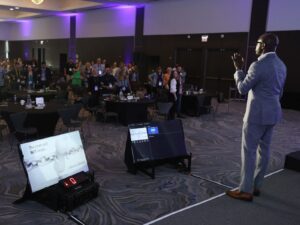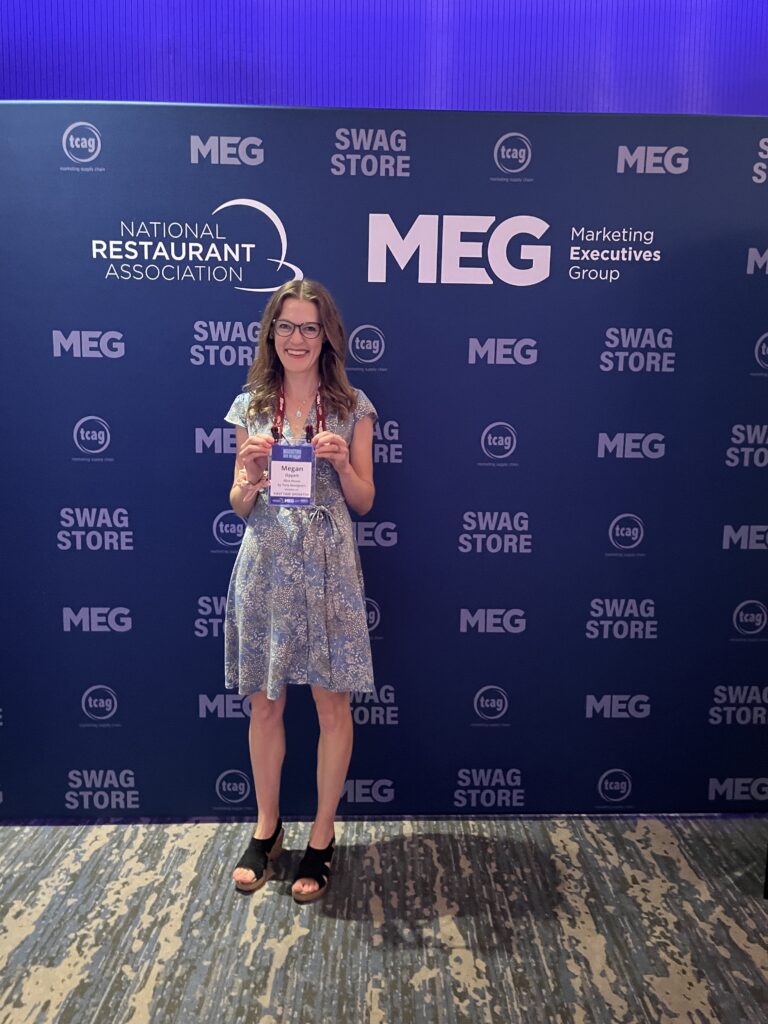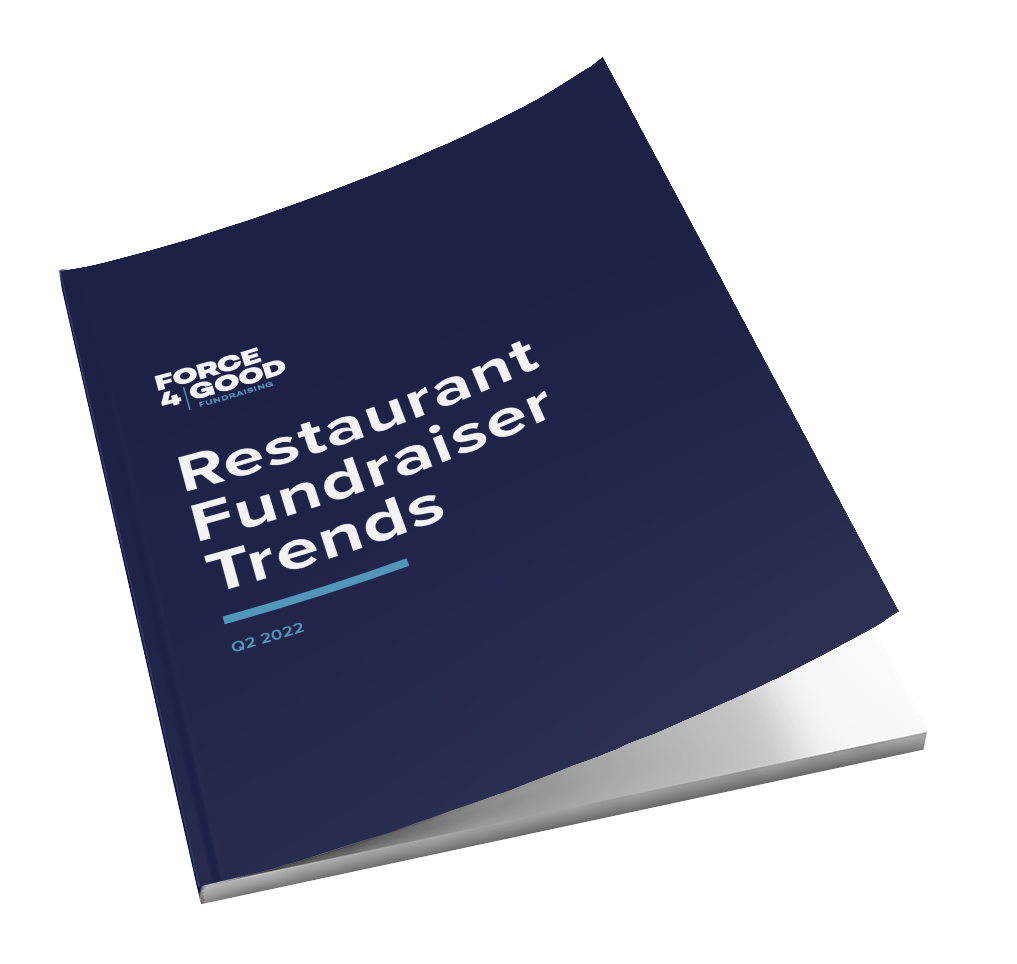
I was fortunate to attend this year’s Marketing Executives Group (MEG) conference in Chicago, the precursor to the National Restaurant Association Show. I’m excited to share my learnings and hope you find insights you can take back to your own brand and projects.
-Megan Oppelt, Marketing Consultant
The Marketing Executives Group (MEG) Conference brought together top minds in the restaurant industry to share insights, discuss emerging trends, and collaborate on innovative strategies. Held in Chicago, this year’s conference was an incubator of ideas to enhance marketing efforts, drive customer engagement, and leverage technology for growth. Here’s a comprehensive recap of the key discussions and takeaways from the conference.

Emotion by Design: Creative Leadership Lessons from a Life at Nike
Speaker: Greg Hoffman, Former Nike Chief Executive Officer and Author of Emotion by Design
In an inspiring and insightful talk, Greg Hoffman drew from nearly three decades of experience at Nike to share powerful lessons on the importance of creativity. Greg highlighted three key principles that guided his work: creativity as a team sport, daring to be remembered, and aiming to leave a legacy rather than just a memory. These principles fueled his efforts at Nike, where he played a crucial role in shaping the brand’s voice and identity through compelling storytelling and memorable experiences.
Greg emphasized that creativity thrives in a collaborative environment. By fostering a team-oriented approach, organizations can unlock the full potential of their creative talents. He encouraged attendees to embrace bold ideas and strive for impact, urging them to create work that stands out and endures over time.
To build an empowering brand that resonates deeply with people, Greg advised tapping into the collective creativity within the organization and unleashing it into the world. This approach, he argued, leads to the creation of authentic, powerful brand experiences that leave a lasting impression and contribute to a meaningful legacy.

Panel: Future in Focus – Integrating Marketing, Technology, and Operations
Moderator: Kim DeCaolis, SVP Strategic Growth, Craveworthy Brands
Panelist: Paul Macaluos, President & CEO, Another Broken Egg Cafe
Panelist: Beth Hardy, Vice President, Marketing Modern Restaurant Concepts (Modern Market Eatery)
Panelist: Jamie Richardson, Vice President and Marketing & PR, White Castle
Employee Incentives and Engagement
The “Future in Focus” panel discussed the intersection of marketing, technology, and operations, with a particular focus on employee incentives and engagement. Panelists shared insights on using apps to incentivize and engage employees. These apps allocate points for achievements such as being named Employee of the Month or winning an add-on check contest which can be redeemed for gift cards. They also facilitate communication by sending notifications about promotions, best practices, contests, and training.
Empowering Teams
Richardson said, “Share the why behind marketing actions with the team members so they can get behind them.” This ensures alignment with company goals and helps employees feel valued and invested in the business’s success.
Panelists also discussed the importance of using guest feedback tools to share positive feedback with general managers. This practice boosts morale and incentivizes the team to work toward more positive feedback.
Panel: From Posts to Plates – Social Media Success Stories
Speaker: Dan Bejmuck, CEO & Founder, Dreambox
Speaker: Pam Nedwetzky, Director, Marketing, Grimaldi’s Pizzeria
Speaker: Alonso Castaneda, President, Pincho Burgers & Kebabs, Vice-President Brand Development, Savory Restaurant Fund
Harnessing the Power of Social Media
The “From Posts to Plates” panel focused on leveraging social media to engage younger audiences, particularly Gen-Z. Panelists highlighted that Gen-Z increasingly relies on TikTok for discovering new restaurants, rather than traditional review sites like Yelp. Some interesting stats:
- 40% of Gen Z do not use Yelp or Google Maps to search for local restaurants
- 75% of Gen-Z has never written a Yelp review
Engaging Gen-Z on TikTok
One notable example discussed was a Chick-fil-A employee who gained a significant following on TikTok by reviewing menu items during her lunch breaks. Instead of embracing this opportunity, Chick-fil-A initially discouraged her, resulting in her moving to Shake Shack where her influencer role was celebrated. This highlighted the importance of allowing employees to be brand ambassadors and leveraging social media trends to boost brand visibility.
Adapting to Social Media Dynamics
The panelists emphasized the need to stay true to the brand voice while adapting to social media dynamics. For instance, Grimaldi’s Pizza adapted to local preferences in Texas by creatively promoting ranch dressing, and maintaining their New York aesthetic while satisfying customer demands. Flexibility in responding to customer feedback on social media can lead to the successful introduction of new menu items. Nedwetzky said: “Know who you are (on social) and stay true to your brand. This doesn’t mean you can’t change, you just have to make choices. Some things you’re not gonna give up. Some things you can evolve.” And the rules for social are different than the rules related to other marketing strategies! Panelists talked about challenging conventional limits on social media to go viral and taking liberties to post things without the regular chain of approval to catch hot trends.
Panel: AI – Beyond the Hype
Speaker: Zach Goldstein, CEO & Founder, Thanx
Speaker: Abhinav Kapur, CEO & Co-Founder, Bikky
Speaker: Jen Faren, Vice President Marketing, Hopdoddy
Practical AI Applications
The “AI: Beyond the Hype” panel explored practical applications of AI in the restaurant industry. Panelists discussed how AI can enhance business outcomes by improving customer interactions, operational efficiency, and data analysis. In a world where More than 70% of US workers use generative AI at work, the many applications include marketing, data insights, back-of-house, and guest-facing.
Enhancing Customer Interactions
Examples of AI in action included White Castle using AI voice technology in drive-thrus and Hopdoddy using AI to handle phone orders. AI can remember repeat customers’ preferences, offering a personalized experience each time they order. Analyzing customer behavior and predicting lifetime value enables targeted marketing efforts and improves customer retention.
Operational Efficiency
AI also enhances operational efficiency. Sweetgreen uses robots to prepare salads, adding a theatrical element to the dining experience, which engages customers. Chipotle uses robots to make chips, ensuring they look handmade while maintaining quality. Dominos had a virtual camera to check the pizza to ensure operational standards were met. These innovations streamline operations and enhance the overall customer experience.
Data-Driven Decision Making
The panel emphasized that data is a scale game. AI helps analyze customer behavior patterns, enabling restaurants to tailor their upsell strategies. Look at data to upsell the right thing to the right guest at the right time. For example, AI can suggest specific items based on individual preferences instead of asking every customer if they want fries, increasing the likelihood of upsell success.
Panel: Unlocking the Value of Loyalty Programs
Speaker: Kevin O’Connell, Managing Director, Grant Thorton
Speaker: Aaron Noveshen, Founder & CEO, Starbird
Keys to Successful Loyalty Programs
This panel discussed common pitfalls and best practices for loyalty programs. Panelists emphasized the importance of understanding customer values and behaviors. Focusing on frequency and spending can be less effective than targeting specific behaviors and values-based incentives. O’Connell said “ Your top customers are always changing- it’s very uncommon for a customer who moves up a loyalty tier one year to move up again a second year. Performance segmentations are a point-in-time measurement, they don’t tell a story about the customer- ‘decile 1’ is not a group of similar customers.”
Kevin showed the keys to success as:
- Know who your guests are
- Send them the right message at the right time
Innovative Approaches
O’Connell said “Capturing guest behavior and offering personalized incentives enhances customer engagement and loyalty. People live their lives around activities, not products and services. Brands don’t create demand, they capture the share of customers in the market through brand awareness, accessibility, and different products and experiences.”
Aaron Noveshen of Starbird shared success by implementing a points-based loyalty program and targeting guests based on preferences and behavior rather than frequency and spend. This approach led to significant increases in loyalty transactions by 14% and rewards usage by 34%.
Challenges and Solutions
The panel discussed challenges like unused rewards and difficulty in changing purchase behavior. They emphasized the importance of analyzing customer data to gain insights and create targeted marketing strategies. Discount emails may not perform as well as segmented emails that offer personalized rewards.

Speaker: Leading a 5-Star Team
Speaker: Dr. Bryan K. Williams, Keynote Speaker, Former Global Corporate Director of Training and Organizational Development at Ritz-Carlton
Building a Positive Culture
The “Leading a 5-Star Team” panel emphasized the importance of setting high expectations and believing in employees. An organization’s culture is shaped by what is celebrated, demonstrated, and tolerated. Recognizing and celebrating employee achievements fosters a positive work environment and motivates team members.
Personalized Recognition
Effective leaders understand what motivates their team members and tailor their recognition efforts accordingly. “Recognition is about the recipient, not the giver. It’s not about what you want to give, it’s about what they want,” said Williams.
Empowering Leaders
Leaders play a crucial role in maintaining high standards and motivating their teams. Empowering employees to take ownership of their work and providing them with the necessary tools and support ensures that employees feel valued and invested in the company’s success. “There are many employees who want to work for a leader who has high expectations and believes in them,” said Williams.
Fostering Employee Engagement
Fostering employee engagement involves transparent communication and involving employees in decision-making processes. This boosts morale and encourages a sense of ownership and accountability, ultimately leading to better performance and customer satisfaction.
Roundtable: Leveraging Limited-Time Offers (LTOs)
Creating Buzz with LTOs
Participants emphasized the importance of working with food vendors’ culinary teams. These teams are attuned to the latest food trends and can provide valuable input for developing LTOs. By leveraging these teams, restaurants can craft offerings that resonate with current consumer preferences and generate excitement.
LTOs are designed to create buzz and drive foot traffic, but their success depends on proper execution. A marketing-driven approach, where the marketing team collaborates with the culinary team, ensures that new ideas are both feasible and marketable.
Measuring Success
Measuring the success of LTOs involves more than just sales figures. Attendees shared various methods for evaluating LTO performance, such as comparing sales to regular menu items and collecting in-store feedback. One effective strategy is to use guest surveys with QR codes, offering incentives to encourage participation. These surveys can assess aspects like marketing appeal, taste, value, quality, and the likelihood of repeat orders, helping to test the pricing elasticity and overall appeal of the LTO.
Roundtable: Expanding Catering and Event Services
Tapping into New Markets
The catering and events roundtable revealed significant opportunities for growth in the restaurant industry. The industry standard for catering is 18% of sales, indicating that many establishments are not fully capitalizing on this revenue stream. The discussion focused on expanding marketing efforts beyond traditional business office catering to include weddings, birthday parties, family gatherings, and social events.
Participants emphasized the importance of visible promotion within the restaurant, such as signs reminding customers about available event spaces. Additionally, ensuring that catering services are prominently advertised on the restaurant’s website can increase awareness and drive bookings.
Streamlining and Personalizing Services
Simplicity and reliability are key factors for successful catering services. Customers prioritize ease of ordering and consistent service. Personalization also plays a significant role; for example, labeling boxes with guest names or creating custom menus for special events can enhance the customer experience and foster loyalty.
Incentives for ordering, such as discounts or thank-you notes, can also promote catering services and encourage positive reviews. These strategies help build a strong reputation and increase repeat business.
Conclusion
The MEG Conference in Minneapolis offered a wealth of insights and practical strategies for enhancing marketing efforts in the restaurant industry. From leveraging LTOs and expanding catering services to enhancing loyalty programs and integrating AI, the conference provided actionable takeaways for attendees. The emphasis on personalization, employee engagement, and data-driven decision-making underscored the importance of staying adaptable and finding ways to drive sales in an ever-evolving industry.


